Use of AI-backed OCR in the healthcare system
Anmol Kalra | 27th August 2021

There is no secret to it that healthcare costs have skyrocketed in recent times. With the surge in the demand and supply of healthcare equipment and facilities, there is a massive rise in produced data. This puts the healthcare system on the verge of fraud and data improvisations to benefit the receiver or the provider.
AI is breaking new ground with its innovative tools and methods. With the rise of demand in the healthcare industry, a creative and smart approach to these traditional problems has become necessary.
One such AI-backed tool is Optical Character Recognition (OCR).
Artificial Intelligence has wide applications and usage. OCR, which has already proved its mettle by being 99% accurate, works efficiently using its various data-capture and functional capabilities.
Before jumping any further, let’s dive into the world of Artificial Intelligence to know how OCR could help the healthcare industry.
Table of content
Why Artificial Intelligence in Healthcare?
AI-backed OCR in data capture and extraction
The framework used in AI-backed OCR in documents digitization of healthcare records
Pre-processing
Post-Processing
Why Artificial Intelligence in healthcare?
When we talk about health and AI, we look towards the promise that Artificial Intelligence (AI) keeps on the table to improve every aspect of our healthcare system.
But what was the need to incorporate AI in our healthcare?
The answer lies in the fact that there are still hurdles to overcome to achieve a total AI-backed health care routine. AI is swiftly adopted in the healthcare routine. AI, in an application, is even helping people monitor themselves in their homes.
Prominent hurdles faced by traditional healthcare system–
- Data privacy concerns of the patient.
- Fear of mismanagement due to lack of human overlook.
- Data mismanagement.
- Extraction of relevant data from medical reports, invoices, and prescriptions given by the doctor.
With the surge in online healthcare options, the healthcare system is overburdened with data. From managing a patient’s health records to keeping track of his past medical history, automation of the system has become a necessity.
AI tools can support the healthcare system by providing leading issues fluently and analyzing/extracting correct data to identify trends or information that would lead a patient to a particular disease. When time can save lives, AI and machine learning can be transformative not only for healthcare but for every individual seeking help.
AI-backed OCR in data capture and extraction
Optical Character Recognition (OCR) is the AI-backed tool that allows the software to interpret text on scanned images and extract their data.
We use OCR widely in automated document classification and data-gathering solutions. It ensures a smooth transfer of data as well as vital statistical information with minimal errors.
OCR “reads” and identifies the documents before deciding which data to extract in the given business process. OCR, when integrated with other programs like Data Management Systems, brings refined benefits for organisations. This technology is generally used to automate business data entry processes of document digitisation in the healthcare system.
To be functional in the new era of the healthcare industry, you need an innovative and intelligent service provider to your problems. One such company that provides AI-OCR solutions with machine learning and computer vision algorithms to automate data scanning with efficiency and accuracy is Oodles AI. Oodles AI Development Company has 11+ years of experience in providing resilient AI-OCR solutions in healthcare systems.
AI-OCR uses various Deep Neural Networks (DNN) techniques to extract the relevant data and process a refined and structured text image. This, if incorporated correctly, could help in easy management of data, cost reduction, errors-reduction with fast and secure availability of digital data. The demand for accuracy and minor human errors in this sector is more profound than in most other sectors.
The framework used in AI-backed OCR in documents digitisation of healthcare records
Artificial intelligence uses Blockchain technology and OCR to deliver a framework that resiliently extracts the data/text from the hard document and stores it in a digital space.

Framework for AI-powered OCR in document digitization
Pre-processing and Post-processing are two significant steps used byAI-OCR.
♦ Pre-processing
Step1. Automation Data acquisition
The first obligatory process uses AI-OCR to scan and extract the required data(Text/charts) from the hard copies of the medical records.
The process involves various methods used to convert the low-quality image into readable and understandable text. AI-OCR backed with Conditional generative adversarial networks creates an infrared image of an object as an input and produces a binary mask of the image as an output.
1) Autocropping the image
2) Skewing the text in an aligned format
3) Image binarization involves converting greyscale images into black-and-white (B&W) images using an appropriate threshold algorithm.
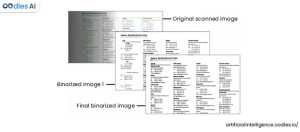
4) Despeckling of image: The extra noise covering the text is suppressed using the Synthetic Aperture Radar (SAR) acquisition method.
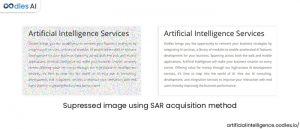
Various other irregularities such as extra lines, text over images, scribbling over texts are eliminated using the OCR technique.
Also Read:- Improving Data Analysis with AI-powered OCR Applications
Step2. Data processing
The acquired data is now pushed for the Pattern Recognition process. The particular type of deep convolutional neural network (DNN) combines bottom-up recognition and top-down imagination techniques to minimize minute errors and predict the excluded objects.
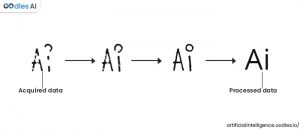
AI powered Pattern Recognition Process enabling excluded objects
In addition, the multi-layered nature of a DNN allows each layer to encode distinctive features.
The DNN model uses a Conditional Generative Adversarial Network( cGAN) that learns a mapping from an input image to an output image.
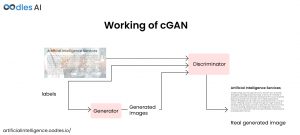
Conditional generative adversarial networks can be used to reconstruct partially clogged objects and produce a complete image using the pattern detection module.
Step3. Data Analysis
The processed data is now analyzed prominently for image zoning and final skewing of text. In addition, deep Convolutional Neural networks (CNN) remarkably improved image classification by enhancing object detection and segmentation.
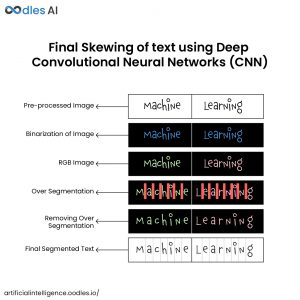
Handwriting Text Recognition (HTR) using Terraform
Optical Character Recognition (OCR) systems transcribe text contained in the scanned images or documents into digital text. HTR system strengthens business security and authenticity using accurate signature matching and handwriting recognition. Oodles AI trains OCR systems with Keras APIs and artificial neural networks to improve their accuracy and efficiency.
♦ Post-Processing
Various data classifiers and predictive models are used for the final processing of text.
Deep learning uses Long Short-term Memory (LSTM), a part of the Recurrent Neural Network (RNN), to process the final error-free text.
Artificial Intelligence is the future of an intelligent healthcare system. From virtual assistance of doctors to home delivery of medicines. AI, machine learning incorporated with deep learning are here to stay in the healthcare industry.
Establishing Personalized OCR services With Oodles AI
AI-powered OCR tools are sleeping giants of digital transformation. They have the potential to help numerous organizations to automate the processing and build error-free physical documents.
Combining Artificial Intelligence and OCR is proving to be a winning strategy for both data management and automation. Reducing the administrative burden from humans in healthcare is key to making workflow and the staff more productive.
At Oodles AI, we acquire the power of artificial intelligence to improve data capture and extraction processes for your business. We expand machine learning models and various functional algorithms to automate data extraction from structured and unstructured physical documents, including-
(a) Adhaar card and identity cards
(b) Invoices and billing documents
(c) Application and prescription forms with insurance-related documents
(d) Healthcare reports and medical records
Collaborate with us to revitalize your AI Solutions to build and deploy robust OCR software to achieve your automated goals.



